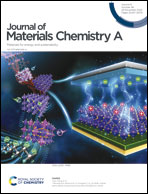Iron-based nanoparticles encapsulated in super-large 3D carbon nanotube networks as a bifunctional catalyst for ultrastable rechargeable zinc–air batteries†
Abstract
The advancement of rechargeable zinc–air batteries (ZABs) largely relies on reasonable design and fabrication of robust oxygen electrocatalysts. However, due to the unsatisfactory electrocatalytic activity and low stability of oxygen electrocatalysts for air cathodes, ZABs suffer from sluggish charging/discharging dynamics and short cycling life. Here, a unique pea-like architecture of Fe nanoparticles encapsulated in super-large carbon nanotubes (Fe/CNT) is designed as an excellent bifunctional oxygen catalyst. The super-large 3D carbon nanotube networks not only increase the electronic conductivity and avoid the corrosion and deactivation of the catalyst, but also enhance the natural catalytic activity due to the electron redistribution between Fe and CNTs. As a result, the Fe/CNT catalyst exhibits a large current density at a potential of 0.82 V for the ORR and a low overpotential of 330 mV at 10 mA cm−2 for the OER. Furthermore, the assembled ZABs achieve a high power density of 137.5 mW cm−2 and ultra-stable cycling stability over 3000 h at 5 mA cm−2 as a new record among the reported rechargeable ZABs.



 Please wait while we load your content...
Please wait while we load your content...